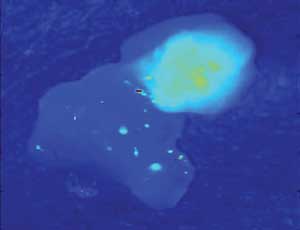Compiled by BioPhotonics staff
Parathyroid glands – four small organs the size of grains of
rice located at the back of the throat – are very difficult to identify with
the naked eye, and they can be damaged during surgery to remove a diseased thyroid.
Now, scientists have discovered that the glands glow with a natural fluorescence
in the near-infrared region of the spectrum, and this unique fluorescent signature
could allow endocrine surgeons to detect and positively identify them to avoid injury.
Not only are parathyroid glands difficult to see, but they can
be found in different locations from person to person. It takes a microscope to
reliably tell the difference between the parathyroid tissue and the thyroid and
lymph tissue that surround it. Even with magnification, it is difficult to distinguish
the parathyroid.

Parathyroid tissue in the upper right emits a natural fluorescence in the infrared spectrum
that is twice as strong as that of thyroid tissue, in the lower left. The difference
is strong enough that a simple optical system can distinguish between the two during
endocrine surgeries. Courtesy of Mahadevan-Jansen Laboratory.
Biomedical engineers and endocrine surgeons at Vanderbilt University
have discovered that the parathyroid tissue glows naturally with fluorescence that
is so strong that detecting the tissue does not require expensive or sophisticated
instruments, potentially reducing the risk of parathyroid damage during neck surgery.
The team assembled a detector from off-the-shelf hardware consisting
of a low-power infrared laser connected to an optical fiber probe. As the fiber
illuminates the tissue with invisible near-infrared light, a detector, connected
to other fibers in the probe, measures the strength of the fluorescence that the
laser excites. The university has applied for an international patent to cover the
application.
Although accurate, the first generation of the device was difficult
to use because surgeons had to dim the lights for it to work. This will not be the
case for the newer version, which will include a filter that will block out visible
light. According to the surgeons, the system will be more user-friendly with the
addition of a camera that displays the fluorescence of all the tissues in the throat
on a single display.
The cause of fluorescence in parathyroid tissues remains a mystery,
but the scientists asserted that the uncertainty will not get in the way of using
their method to improve the effectiveness of parathyroid surgeries and to reduce
the damage done to the glands during other endocrine surgeries.
Details of their work were described in the June 8 issue of the
Journal of Biomedical Optics (doi: 10.1117/1.3583571).